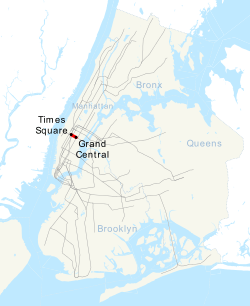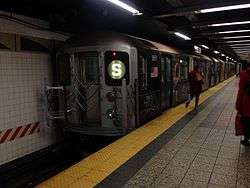42nd Street Shuttle
| 42nd Street Shuttle | |
|---|---|
 | |
|
42nd Street Shuttle train of three ad-wrapped R62A cars at Grand Central. | |
 | |
| Northern end | Times Square |
| Southern end | Grand Central |
| Stations | 2 |
| Rolling stock | 10 R62As (3 trains) |
| Depot | Westchester Yard |
| Started service | August 1, 1918 |
| 42nd Street Shuttle | |
|---|---|
| Overview | |
| Type | Rapid transit |
| System | New York City Subway |
| Status | Operating |
| Locale | Midtown Manhattan |
| Termini |
Times Square Grand Central |
| Stations | 2 |
| Operation | |
| Opened | October 27, 1904 |
| Owner | City of New York |
| Operator(s) | New York City Transit Authority |
| Character | Underground |
| Rolling stock | R62A |
| Technical | |
| Line length | 0.81 miles (1.30 km) |
| Number of tracks | 3 (formerly 4) |
| Track gauge | 1,435 mm (4 ft 8 1⁄2 in) |
| Electrification | 625V DC third rail |
The 42nd Street Shuttle is a New York City Subway shuttle train service that operates in Manhattan. Part of a former Interborough Rapid Transit Company (IRT) line, it is sometimes referred to as the Grand Central / Times Square Shuttle, since these are the only two stations served by the shuttle. It runs at all times except late nights, connecting Times Square to Grand Central under 42nd Street. It is the shortest regular service in the system, running about 3,000 feet (910 m) in under two minutes.[1]
The 42nd Street Shuttle is part of the A Division of New York City Transit, and the tracks that it uses opened in 1904 as part of the first subway in the city. In order to distinguish it from the other shuttles in the system, NYCT Rapid Transit Operations internally refers to it as the 0 (zero). Its route bullet is colored dark slate gray on route signs, station signs, and rolling stock with the letter "S" on the official subway map.
History
The subway through which the shuttle runs was opened on October 27, 1904, the first day of subway service in Manhattan. It served as part of the IRT mainline until August 1, 1918, when the Dual Contracts' "H system" was put into service, with through trains over the IRT Lexington Avenue Line and IRT Broadway – Seventh Avenue Line, and only shuttle trains under 42nd Street.[2]
The southbound express track on the four-track line was closed and new platforms were built, as the old station at Times Square had been local-only. However, the new arrangement turned out to be inadequate, and the shuttle was closed on midnight between August 3–4 for expansion of the platforms.[3] The shuttle reopened on September 28, 1918, with improved passageways and platforms.[4] On the walls of the stations, black bands (at Times Square) and green bands (at Grand Central) were painted to guide passengers to the shuttle platforms.[5] As part of a demonstration for automation, the shuttle was briefly automated from 1959 to 1964 on Track 4. A severe fire at the Grand Central station on April 21, 1964 destroyed the demonstration train and manual operation had been restored since.[6] The fire began under a shuttle train on track 3, and it became larger, feeding on the wooden platform. The train on Track 1 was saved when the motorman saw smoke, and reversed the train. The basements of nearby buildings were damaged. Tracks 1 and 4 returned to service on April 23, 1964, while Track 3 returned to service on June 1, 1964.[7]
The shuttle ran at all times until September 10, 1995.[8] Since then, it has run at all times except late nights, when passengers must use the 7 train. When the shuttle is closed, the area is sometimes used for movie and TV filming. The French Connection and King of New York, among many other titles, were filmed on the 42nd Street shuttle.
As part of the 2015–2019 MTA Capital Program, the 42nd Street Shuttle will become ADA accessible, and the shuttle will be reconfigured from three tracks to two tracks, and the trains will become six cars long. The whole project will cost $235.41 million. The Times Square shuttle platform will be extended to allow for a second point of entry, this one being at Sixth Avenue, with a connection to the IND Sixth Avenue Line. The Times Square station will be rehabilitated with congestion mitigation measures. A wider stairway would be installed from the shuttle mezzanine to street level, a new control area would be installed at the bottom of the stairway, and 21 columns would be removed. The cost of this part of the project is $28.93 million.[9]
Track connections to the rest of the system
Of the four shuttle tracks, only three are in use, with the former southbound express track space being used for platform space at each terminal. The former southbound local track is now Shuttle Track 1. Track 2 no longer exists, but the trackbed of Track 2 can be seen inside the tunnel from passing trains on Tracks 1 and 3. The former northbound express track is Track 3, and the former northbound local track is Track 4.[10][11]
Tracks 1 and 3 are connected to each other and to the Lexington Avenue Line's southbound local track south of Grand Central station. Track 4 connects to the Broadway–Seventh Avenue Line's northbound local track north of Times Square station. There is no connection between tracks 1 and 3 on the one hand, and track 4 on the other; therefore, it is now physically impossible for a train to go from the IRT Lexington Avenue Line through to the IRT Seventh Avenue Line or vice versa by using the shuttle tracks.[10][11]
As part of the 2015–2019 Capital Program plan, the connection to the Broadway–Seventh Avenue Line would probably be removed with the elimination of Track 4.[9][11]
Operation
| Service | Time period | Section of line | |
|---|---|---|---|
| All except nights | Late nights | ||
| S | service | no service | entire line |
42nd Street Shuttle | |||||||||||||||||||||||||||||||||||||||||||||||||||||||||
|---|---|---|---|---|---|---|---|---|---|---|---|---|---|---|---|---|---|---|---|---|---|---|---|---|---|---|---|---|---|---|---|---|---|---|---|---|---|---|---|---|---|---|---|---|---|---|---|---|---|---|---|---|---|---|---|---|---|
Legend | |||||||||||||||||||||||||||||||||||||||||||||||||||||||||
| |||||||||||||||||||||||||||||||||||||||||||||||||||||||||
In service, each of the shuttle tracks in operation at any given time is independent of the other; e.g., the train on track 1 simply runs back and forth on track 1, and there is no switching involved in reversing at each terminal. To provide for quick turnaround of the shuttle trains, there is an operator at each end of the train. Depending on which direction the train is traveling the operators swap jobs when the train gets to one end; one acts as the operator in the front and the other acts as conductor in the rear.
It is common for shuttle trains to be adorned with excessive advertising. Since 2008, the MTA has tested full-train advertisements on 42nd Street Shuttle rolling stock.[12] While most advertisements are well received, a few advertisements—such as one for the TV show The Man in the High Castle, which featured a Nazi flag—have been controversial.[13]
Stations
| Station service legend | |
|---|---|
| |
Stops all times |
| |
Stops all times except late nights |
| |
Stops weekdays only |
| |
Stops weekdays in the peak direction only |
| Time period details | |
| |
Stations | |
Subway transfers | Connections |
|---|---|---|---|---|
| Manhattan | ||||
| 42nd Street Line | ||||
| |
Times Square | 1 7 N A |
Port Authority Bus Terminal | |
| |
Grand Central | |
4 7 |
Metro-North Railroad at Grand Central Terminal |
References
- ↑ "S Subway Timetable Between Grand Central Station and Times Square, Manhattan, Effective November 7, 2016" (PDF). New York Metropolitan Transportation Authority. Retrieved November 7, 2016.
- ↑ "Open New Subway Lines to Traffic; Called a Triumph". The New York Times. August 2, 1918. p. 1. Retrieved October 4, 2011.
- ↑ "Drop Shuttle Plan as Subway Crush Becomes a Peril". The New York Times. August 3, 1918. p. 1. Retrieved October 4, 2011.
- ↑ "Shuttle Service In Operation". pudl.princeton.edu. Interborough Rapid Transit Company. September 27, 1918. Retrieved 2016-09-19.
- ↑ "Subway Shuttle Resumes Today". The New York Times. September 28, 1918. p. 17. Retrieved October 4, 2011.
- ↑ "www.nycsubway.org: IRT Times Square-Grand Central Shuttle". Retrieved May 2, 2016.
- ↑ Cunningham, Joseph; DeHart, Leonard O. (1993-01-01). A History of the New York City Subway System. J. Schmidt, R. Giglio, and K. Lang.
- ↑ Perez-Pena, Richard (September 11, 1995). "A Subway Station Is Shuttered, the First in 33 Years". The New York Times. Retrieved October 4, 2011. [the article is about Dean Street on the Franklin Avenue Shuttle, and the headline refers to the 1962 closing of Worth Street; several old-style elevated railways were closed since then, as well as the Culver Shuttle which hosted both elevated and subway service at one time]
- 1 2 "METROPOLITAN TRANSPORTATION AUTHORITY (MTA) NOTICE OF PUBLIC HEARING AND DESCRIPTION OF PROJECTS Tuesday, August 23, 2016 4:30 P.M. Request for Federal Financial Assistance Under the Federal Transportation Authorization For Federal Fiscal Year 2017 Capital Improvement Projects" (PDF). mta.info. Metropolitan Transportation Authority. July 28, 2016. Retrieved August 7, 2016.
- 1 2 Marrero, Robert (2015-09-13). "469 Stations, 846 Miles" (PDF). B24 Blog, via Dropbox. Retrieved 2015-10-09.
- 1 2 3 Marrero, Robert (2015-09-13). "469 Stations, 846 Miles" (PDF). B24 Blog, via Dropbox. Retrieved 2015-10-09.
- ↑ "Untapped Mailbag: Advertising Takeovers on the Shuttle to Times Square". Untapped Cities. Retrieved May 2, 2016.
- ↑ "Amazon pulls ads for Nazi-themed TV show from N.Y. subway". Retrieved May 2, 2016.
External links
- MTA NYC Transit – 42 Street Shuttle
- "S Subway Timetable Between Grand Central Station and Times Square, Manhattan, Effective November 7, 2016" (PDF). New York Metropolitan Transportation Authority. Retrieved November 7, 2016.
- nycsubway.org – IRT Grand Central / Times Square Shuttle
- Abandoned Stations – proposed Grand Central shuttle platform (includes a track diagram)






